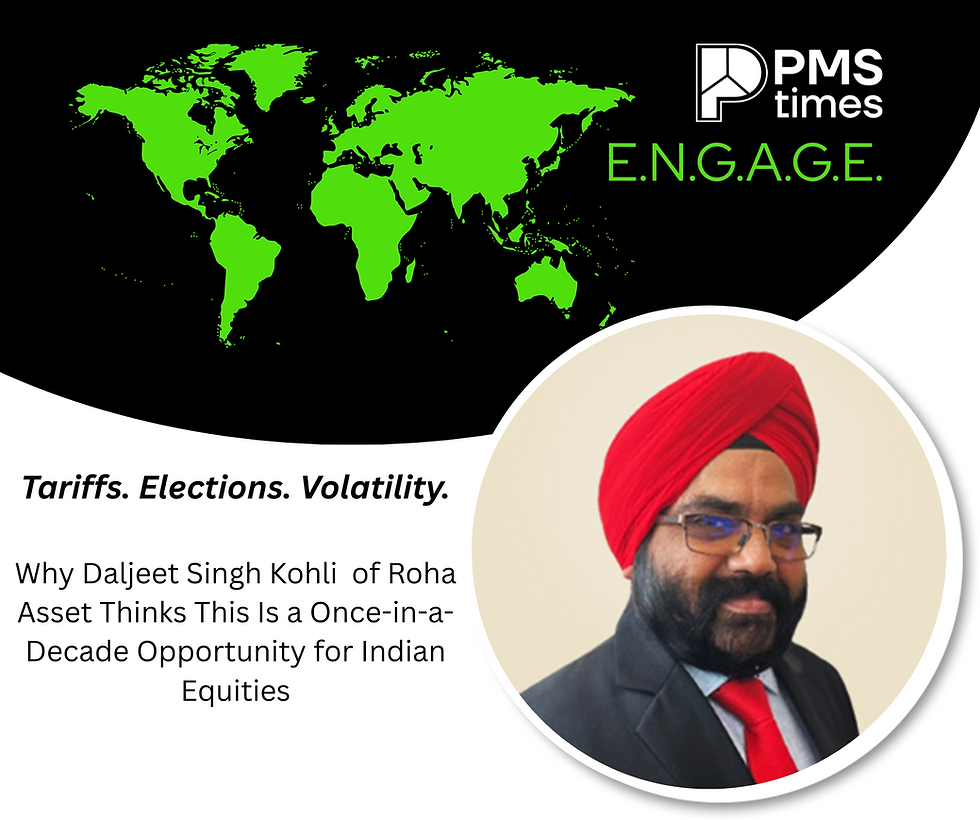Beyond the Obvious: Rajesh Pherwani on Creating True Alpha in Indian Markets
- Harbir Singh
- Jul 4
- 3 min read

In a recent live session hosted by PMStimes, seasoned fund manager Rajesh Pherwani, Founder & CIO of Valcreate Investment Managers LLP, walked us through his investment ideology, market frameworks, and real-world examples of identifying v
alue where the market sees none. What followed was an insightful hour that not only unpacked his process but also reminded everyone that wealth is created in silence — when t
he crowd isn’t watching.
🎯 The Genesis of Valcreate — Value, Not Just Wealth
Launched in 2017-18, Valcreate stands for “Value Creation”, but with a dual lens — not just in terms of returns, but in investor experience and education. Rajesh described it as a “career child” built after over two decades of research and fund management at HDFC AMC, L&T Mutual Fund, and other top institutions.
Valcreate currently manages four PMS strategies, two of which are led by Rajesh:
Growing India Strategy – a flexi-cap fund focused on India's structural growth themes
Life Sciences & Specialty Opportunities – a thematic portfolio built on pharma, specialty chemicals, and agrochemicals
🧠 The Investment Playbook: Blend of Growth and Turnaround
Pherwani’s approach hinges on two buckets:
Secular Growth Compounding – Companies that grow consistently at 15–25% annually with solid fundamentals. Think Bharat Electronics, Divis Labs, or housing finance plays.
Value/Opportunity Plays – These are companies going through temporary downturns but operating in structurally sound industries. Examples included public sector banks like Bank of Baroda (picked at ₹90, now ~₹240), and agrochemical companies post-COVID inventory dump from China.
This dual structure ensures that growth remains balanced with valuation comfort, and risks are diversified across business cycles.
🔍 Filters That Matter: Sizing the Opportunity
So how does Valcreate separate a deep value gem from a value trap?
Rajesh laid out a simple but powerful mental model:
Size of the opportunity – Is the industry underpenetrated or in a structural upcycle?
Management quality – Has the team delivered through past cycles?
Business resilience – Can it withstand disruption and deliver returns through economic shocks?
Reasonable valuation – Is the market overreacting to a temporary problem?
His frameworks have successfully identified winners like Divis Labs during an FDA-led crash in 2017–18, and PSU Banks in 2021 when NPAs fell sharply post IBC/NCLT reforms.
🧩 What Makes PMS Different — And More Agile
Unlike mutual funds, PMS structures allow for:
Personalized entry timing — newer investors don’t buy overvalued names
Focused stock selection — typically only 15–20 names per strategy
Custom allocation — each portfolio can be individually tailored
Real-time risk management — sector trimming or position exits happen fast
This agility has shown up in performance: during COVID, Valcreate’s pharma/chemicals-heavy portfolio delivered +30% when the broader markets were -30%.
📈 India’s Long-Term Setup: The Next 20 Years
Pherwani’s view on India’s macros is unapologetically optimistic — but rooted in fundamentals, not narrative.
Consumption is 70% of GDP — and high-income segments (₹8–10L+) are growing 12x faster than average
Demat accounts have grown from 4 crore in 2020 to over 18 crore
SIP inflows are ₹25,000+ crore monthly
FII outflows in 2023 (~$30B) were offset by $70B+ from Indian investors
In his words:
“This is a 20-year consumption and innovation story. If you stay process-driven, 15–20% CAGR is achievable — and not just 12% from index investing.”
📉 On Euphoria & Exit Discipline
Addressing how Valcreate avoids getting carried away during bull runs, Rajesh shared:
The use of internal EPS-based valuation models
Looking at what growth rates current prices imply
A focus on discipline, even at the cost of short-term regret
Citing the 2023 railway and engineering stock surge, he noted how some valuations assumed 35–40% CAGR growth — unsustainable in the real world. This is when trimming exposure, even to winners, becomes essential.
💼 Building Alpha in Today’s Disrupted World
In a thoughtful close, Pherwani introduced the “IDEAS” framework he now uses to evaluate companies:
I – Innovation
D – Disruption potential
E – Environmental impact
A – Adaptability
S – Scalability
This framework is particularly relevant in today’s age of digital businesses, quick commerce, and climate-conscious investing. It’s Valcreate’s way of staying relevant without abandoning its core principles.
✅ Final Takeaway: Balanced Conviction
Rajesh’s message was clear — focus on what you understand deeply, don’t chase every theme, and always be mindful of valuation vs. growth potential.
The Life Sciences strategy, in particular, came across as a standout — offering sectoral depth, defensive strength during downturns, and a history of resilient alpha with 22%+ CAGR post-expense performance.
“Alpha isn’t luck. It’s built quietly, with discipline, over time. And India offers the perfect runway for it — if you know where to look.”



Comments